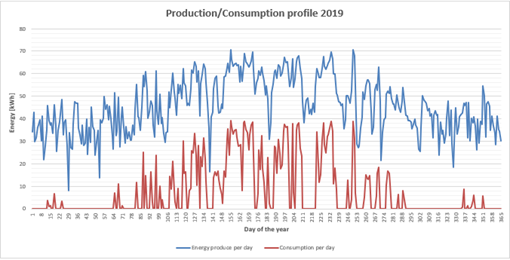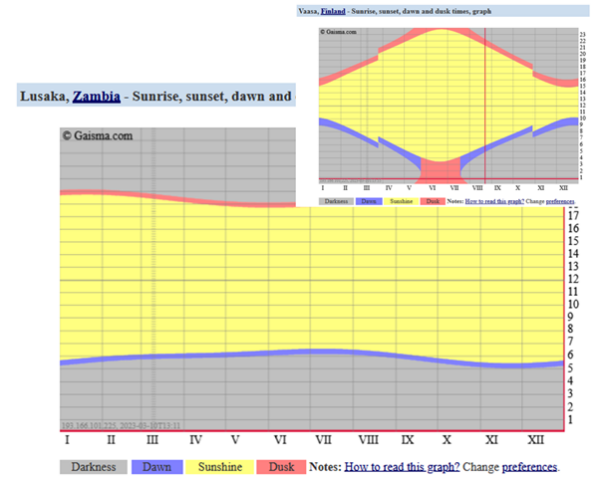Cynthia Söderbacka: ”Analysing the system performance of solar-powered hammermills in Zambia – An EP

The column "Cynthia Söderbacka: ”Analysing the system performance of solar-powered hammermills in Zambia – An EPS case study” was published in Vaasa Insider 24.5.2023.
Cynthia Söderbacka, Project Leader at Novia UAS, writes about a joint project between Novia and two universities in Zambia.
Zambia is located in Africa and, like in many developing countries, the population distribution has constrained the rate and vastnessnes of development. Dependent on hydropower as the main source of energy, the population is concentrated in urban areas with rural communities scattered over large areas.
More than 90 percent of Zambia’s rural population are left without electricity, as connecting them to the grid is not feasible due to financial and geographical challenges.
This has had a domino effect on the people and the environment with consequences such as a high dependency on firewood for energy, poor medical and educational services, and food shortages. Of course, there are also overall socio-economical consequences such as a lack of job opportunities, early marriages, and so on.
In order to alleviate hunger and improve livelihoods, the Zambian government rolled out around 2000 units of solar powered hammermills in 2015. The mills produce mealie meal used in preparing the staple food nshima, a thick paste made from maize flour, eaten with meats and vegetables – comparable to mashed potatoes in Finland.
Mobility for knowledge and cultural exchange
Novia UAS has partnered with two Zambian universities, the University of Zambia and Copperbelt University on a Team Finland Knowledge-funded two-year project: Potential of Nano Grids as a Source of Affordable and Clean Energy for Zambia. The project objective is student and staff mobility for knowledge and cultural exchange.
For Novia UAS, two teams (two semesters) of European Project Semester (EPS) students have been working on the project with the aim of promoting nano grids as an alternative to the national grid for rural areas.
Developing a project website and case study
The first team of Autumn Semester 2022 focused on understanding the energy landscape in Zambia and best energy sources for the nano grids. They documented their work in a report and website that all other students from all the partner universities working on the project are expected to update.
This is to enable all the students that have worked in different phases to follow the project and also to disseminate information, especially to Zambian stakeholders.
The second team of Spring Semester 2023 has a case study to analyse the system performance of two solar-powered hammermills located 400 km apart to see if the current usage pattern is optimal. Students from Zambia are supporting the study by collecting data and making their own analyses as part of their final projects.
The initial plan was to analyse historical data saved on the plants, but the study has instead relied on told stories for usage patterns and performance as well as a simulation of what could have been possible.

Usage patterns emerge
The solar-powered hammermills have an installed capacity in the range of 8-22 kWp, yet hammermills are rated at approximately 7 kW. In some cases, these plants are overly sized, and analysing two models could raise useful points for the many other units scattered across the country.
One of analysed units is a stand-alone system with an installed capacity of 12.75 kWp. The other unit (12.5 kWp) is also partly used to provide lighting and small TV/radio for households in another area 400 km away.
Understanding usage patterns, consumer behaviour and energy source behaviour (figure 2) are at the core of this study.

Use of the hammermills is unscheduled. People go to the milling plant when they see the need and when it suits them. Sometimes, there are interruptions due to changes in power generation, for example, on cloudy days.
Whilst the simulation in figure 1 shows the best period to use the hammermill, it also tallies with the usage pattern described by the operators. The reasons are that crops are ready for harvest and abundantly available between April and October before the next farming season, and the skies are clearer.
The conclusion is that the cases studied are not overly sized but are underutilized and actually experience shortages during the rainy seasons. For the operator to get the most out of the hammermill plants, they need a schedule for each season and use energy storage where possible.
”The size of Zambia and the variability of solar irradiance make it difficult to generalise our results to the 2000 other similar systems in Zambia,” concludes the EPS Team 2023.
